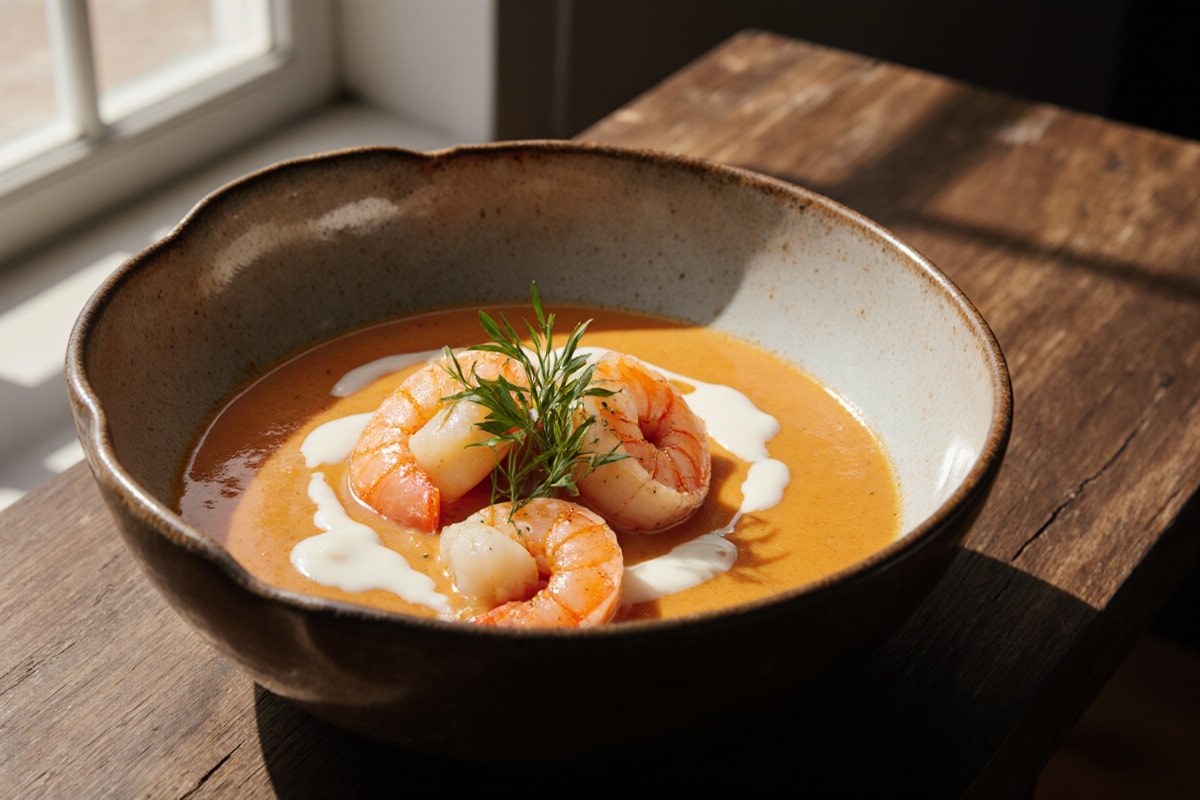Gordon Ramsay Seafood Bisque Recipe
Gordon Ramsay seafood bisque is my secret weapon for impressing dinner guests. The aroma of roasting shells fills the kitchen, igniting your taste buds before you even take a sip. I used to toss random seafood into a pot and hope for the best—major mistake! With Ramsay’s method, I found how to layer flavor and create a rich, velvety texture that makes every mouthful a delight. Trust me, this recipe will save you time and let you cook with confidence. Say goodbye to bland bisques and hello to culinary triumphs right in your own kitchen!

Ingredients for Gordon Ramsay Seafood Bisque
Selecting Quality Seafood
I start with 500 g mixed shellfish: shrimp, lobster tails, and crab legs. Buy fresh or fully thawed frozen—shellfish older than two days at 4 °C is a risk. It should smell clean and briny, not “fishy.”
Save the discarded shells and heads for the stock. Rinse them under cold water to remove grit. That base gives you plenty of savory flavor in about 30 minutes.
Aromatics and Base Flavors
Use 1 large onion (about 150 g), 2 carrots (100 g), 2 celery stalks (100 g), and 4 garlic cloves. Chop into 1–2 cm pieces so everything cooks evenly. Uniformity matters: big chunks take longer, tiny pieces can burn.
You’ll also want 100 g tomato paste for sweetness and color. Tie a thyme sprig, bay leaf, and parsley stalk into a bouquet garni to flavor the stock as it simmers.
Cream, Spirits, and Seasonings
Plan on 200 ml double cream (35% fat) for richness. Use full-fat coconut cream if you need a dairy-free option. Measure 50 ml Cognac or brandy for the classic flambé finish.
Season with salt (1 tsp), white pepper (½ tsp), and a pinch of cayenne. Taste as you go—seafood stocks vary in saltiness. Adjust seasoning after you blend so you don’t over-salt the bisque.
Building the Shellfish Stock
Roasting Shells for Maximum Flavor
Preheat the oven to 220 °C (425 °F). Spread the cleaned shells on a baking sheet in a single layer. Roast 12–15 minutes until they turn bright red and start to char.
That browning adds deeper flavor. If you skip roasting, the stock will taste flatter and less interesting.
Simmering with Aromatics
Move the roasted shells to a large stockpot and add the chopped onion, carrot, celery, and garlic. Pour in 1.5 L cold water or a light fish stock and add the bouquet garni.
Bring to a boil, then lower to a gentle simmer (around 90 °C). Cook for 30 minutes, skimming the foam every 5 minutes. Don’t over-simmer or the stock can turn bitter.
Straining and Degreasing
Strain through a fine-mesh sieve lined with cheesecloth into a clean pot, pressing lightly to get the liquid out. Discard the solids.
Let the stock cool for 10 minutes, then chill in the fridge about 15 minutes so the fat solidifies. Spoon off the fat cap for a clearer-tasting stock.
Cooking and Blending Your Gordon Ramsay Seafood Bisque
Sautéing Aromatics and Tomato Paste
Heat 2 tbsp (30 ml) olive oil or butter over medium heat in a heavy pot. Add the finely diced onion, carrot, and celery and sauté 5–7 minutes until soft and translucent.
Stir in 100 g tomato paste and cook 2 minutes until it darkens and loses that raw edge. Proper caramelization gives the bisque a smoky sweetness.
Adding Stock and Simmering
Pour the degreased shellfish stock into the pot and bring it up to a gentle simmer. You should see steady, gentle bubbles.
Simmer uncovered for 10–12 minutes to marry the flavors. If the volume falls below 1 L, add up to 200 ml water or stock to keep the balance.
Blending to Silkiness
Let the soup cool 5 minutes. Transfer in batches to a high-speed blender; a proper seafood bisque needs a very smooth texture. Blend on high for about 45 seconds until fully smooth.
Strain again through a fine sieve or chinois, pressing down any solids. You want a velvety texture that coats the back of a spoon—no grittiness.
Finishing Touches and Techniques
Incorporating Cream and Seasoning
Return the blended bisque to low heat (60–70 °C). Stir in 200 ml cream gradually so it blends in without breaking. Add the cognac off the flame to prevent flare-ups.
Taste and adjust with salt, white pepper, and a splash (about 5 ml) of lemon juice to brighten the flavor. Always taste after adding cream so you finish the seasoning correctly.
Adjusting Thickness: Roux vs. Cornstarch
To thicken the bisque the traditional way, melt 15 g butter and whisk in 15 g flour over medium heat for 2 minutes before adding stock to make a light roux.
For a gluten-free thickener, mix 10 g cornstarch with 20 ml cold water and whisk it into the simmering bisque. Add it slowly to avoid lumps and overshooting the thickness.
Mistakes to Avoid and Quick Fixes
Too salty? Add peeled potato chunks and simmer 5 minutes, then remove—the potato will pull out some salt. It’s a quick rescue trick.
Too thin? Reduce by simmering 5–7 minutes or add small diced potatoes and cook until tender. If garlic tastes burnt, stir in 10 ml vinegar and 1 tsp sugar to balance it out.
Variations and Alternatives
Spicy Cajun Twist
Stir in 1 tbsp Cajun spice mix (paprika, cayenne, garlic powder) at the cream stage. Add ½ tsp smoked paprika for a smoky kick.
Garnish with chopped scallions and a swirl of hot sauce. This version brings heat and is great on a cool night.
Lobster-Only Luxury Bisque
Use 600 g lobster shells and 300 g lobster meat instead of mixed shellfish. Increase the cream to 250 ml for extra silkiness.
Finish with finely chopped tarragon and a drizzle of truffle oil to make it feel special for date night or a celebration.
Dairy-Free Coconut Version
Swap cream for 200 ml full-fat coconut milk and use coconut oil instead of butter. This keeps the bisque rich without dairy.
Infuse a lemongrass stalk and a piece of ginger in the stock for a Thai-inspired twist. Serve with cilantro and lime wedges for brightness.
Serving Suggestions and Pairings
Classic Garnishes and Bread
Top the bisque with a dollop (15 ml) of crème fraîche, chopped chives, and microgreens. Serve with 2 slices of toasted baguette brushed with garlic oil for dipping.
A small side of crusty sourdough for dunking is always welcome—contrasting textures make the bowl more satisfying.
Wine and Beverage Pairings
Pair a creamy bisque with a crisp Chardonnay (around 12% ABV) or a dry Riesling to cut through the richness. Both work well with shellfish flavors.
For a non-alcoholic choice, sparkling water with a lemon twist refreshes the palate between spoons.
Storing and Reheating Safely
Cool the bisque to 20 °C within 2 hours of cooking, then refrigerate in airtight containers for up to 2 days at ≤4 °C.
Reheat gently over low heat to about 60 °C; avoid boiling or the cream may split. For freezing, use freezer-safe containers and thaw overnight in the fridge before reheating.
Gordon Ramsay Seafood Bisque
Ingredients
Equipment
Method
- Preheat oven to 220°C. Spread cleaned shells on a baking sheet and roast for 12–15 minutes until bright red.
- Transfer roasted shells to a large stockpot. Add onion, carrots, celery, garlic, and pour in cold water or fish stock. Add bouquet garni.
- Bring to a boil, then reduce heat and simmer at 90°C for 30 minutes, skimming foam every 5 minutes.
- Strain stock through a fine-mesh sieve lined with cheesecloth. Let cool, then refrigerate to solidify fat and spoon off.
- In a heavy pot, heat 30 ml olive oil at medium heat. Sauté onion, carrots, celery for 5–7 minutes until soft. Stir in tomato paste; cook for 2 minutes.
- Pour in the degreased shellfish stock and simmer uncovered for 10–12 minutes.
- Cool soup for 5 minutes, then blend in batches on high for 45 seconds until smooth. Strain again for a velvety texture.
- Return blended bisque to low heat; stir in cream gradually. Add cognac off the flame.
- Taste and adjust seasoning with salt, white pepper, and a squeeze of lemon juice.
- For thickness, mix 15 g butter with 15 g flour over medium heat, or whisk 10 g cornstarch with 20 ml cold water into the bisque.
Nutrition
Notes
Love this recipe?
Give us 5 stars and comment!Video tutorial: seafood bisque

FAQ – gordon ramsay seafood bisque
What type of seafood is best for bisque?
Fresh mixed shellfish like shrimp, lobster, and crab give the best flavor. Avoid shellfish that smell ‘fishy’—you want briny freshness!
Can I make bisque without cream?
Absolutely! Substitute with coconut milk or leave it out entirely for a lighter option. But don’t skip the flavor—use aromatics to keep it rich!
How can I fix over-salted bisque?
If your bisque is too salty, drop in a peeled, raw potato for a few minutes. It’ll soak up the excess salt, and you can pull it out before serving.
Is it necessary to strain the bisque?
Yes! Straining gives you that silky texture that coats your spoon. Trust me, you want to avoid any chunky bits ruining your smooth, luxurious soup!
Conclusion
Creating Gordon Ramsay seafood bisque is more than just following a recipe; it’s about understanding and perfecting the layers of flavor. The moment you serve up that shimmering, velvety soup, you’ll bask in the delicious aroma and watch as guests dive in with anticipation. Finally getting it right feels like winning the culinary lottery—each spoonful is a rush of sea-sweetness and rich creaminess. Now it’s your turn — make it bold, make it yours.








